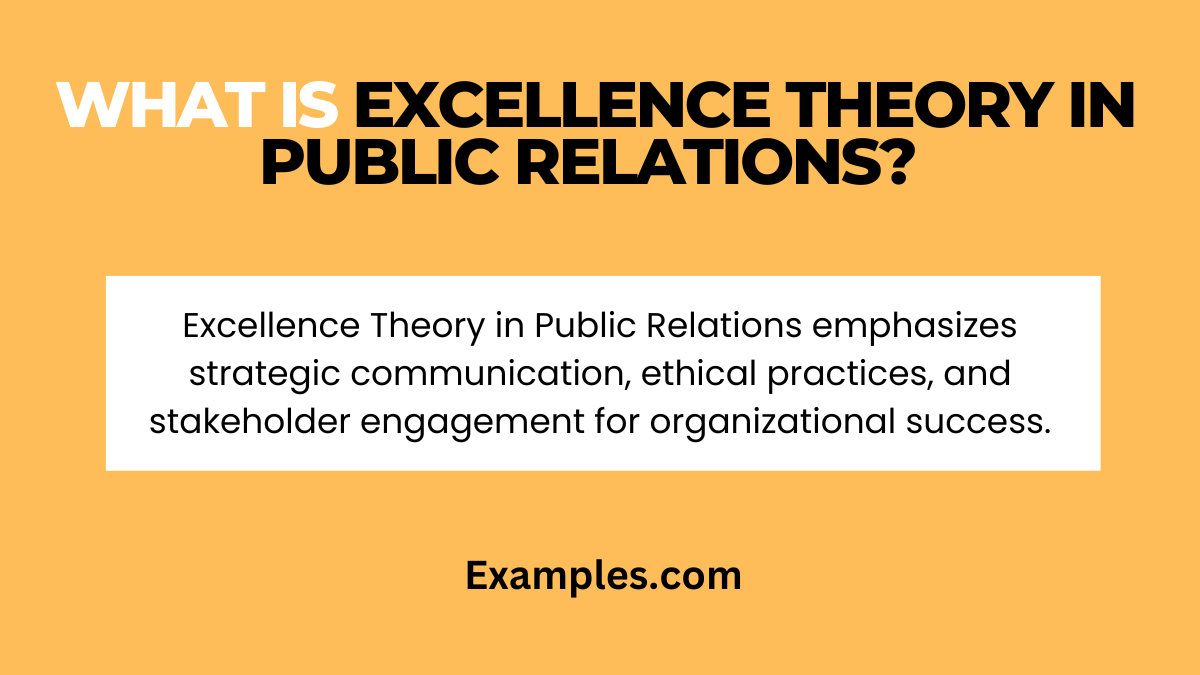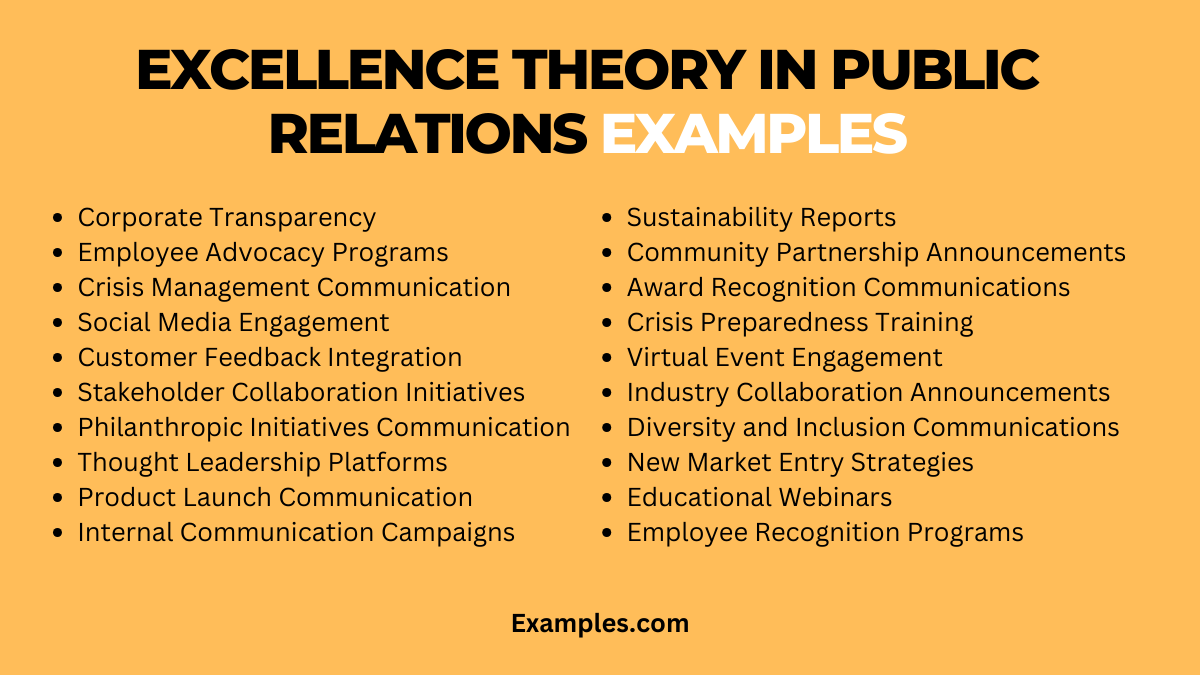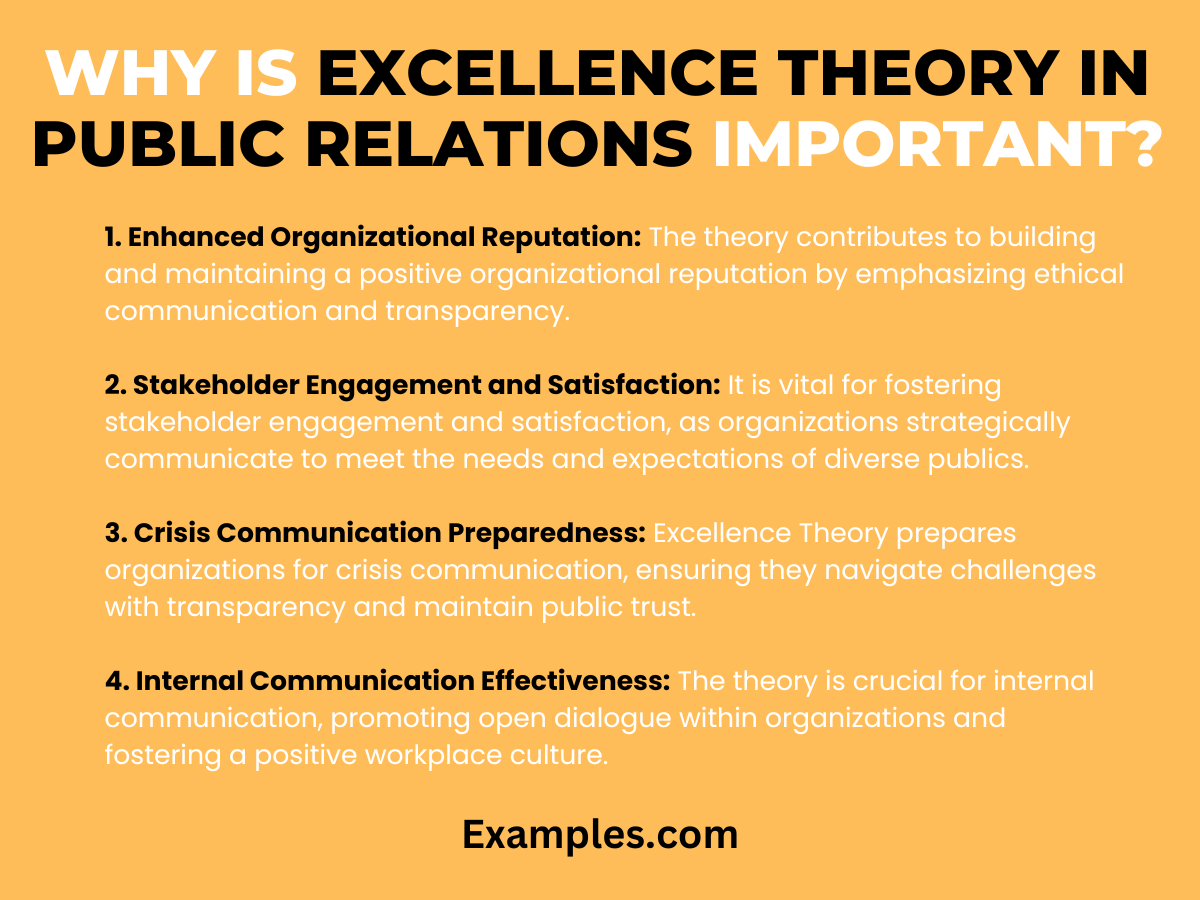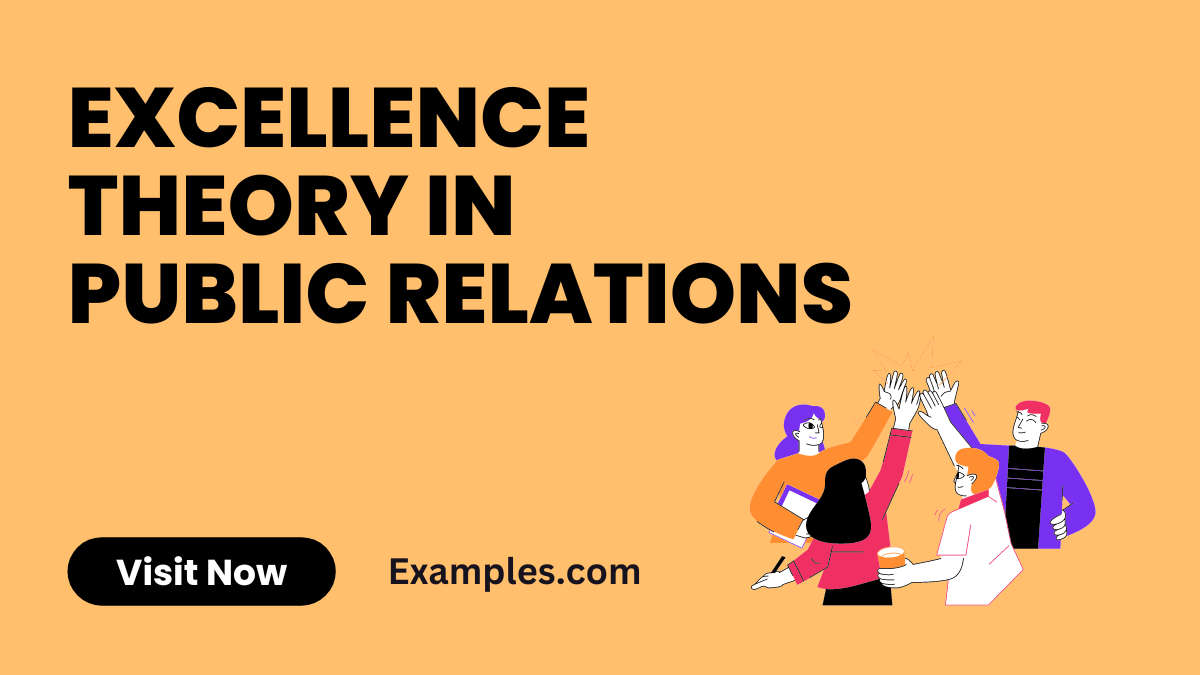19+ Excellence Theory in Public Relations Examples
Unlock the Power of Excellence Theory in Public Relations! Dive into a comprehensive guide, enriched with communication examples, that unveils the art of crafting influential narratives. Explore strategies, tactics, and real-world cases to elevate your PR prowess. Unleash the potential of effective communication and master the nuances of building and maintaining a stellar public image through the lens of Excellence Theory in Public Relations. Elevate your PR game to new heights with expert insights and practical examples.
What is Excellence Theory in Public Relations?

Excellence Theory in Public Relations is a strategic approach emphasizing the pivotal role of communication in organizations. It asserts that organizations achieve success when they prioritize ethical, two-way communication, fostering strong relationships with stakeholders. At its core, this theory highlights the significance of open, transparent, and effective communication as the bedrock of successful public relations efforts. It revolves around cultivating trust, credibility, and mutual understanding between organizations and their audiences.
20 Excellence Theory in Public Relations Examples

Explore dynamic applications of Excellence Theory in Public Relations, where organizations strategically navigate communication challenges. These examples showcase impactful approaches that prioritize ethical, transparent, and audience-centric communication strategies.
- Corporate Transparency: Embrace openness in financial reporting, proactively sharing information to build trust and credibility. Boldly disclose financial performance, reinforcing transparency.
- Employee Advocacy Programs: Empower employees to be brand ambassadors, fostering positive communication. Establish platforms for employees to share experiences, strengthening internal and external relations.
- Crisis Management Communication: In times of crisis, prioritize swift, honest communication. Issue prompt statements addressing concerns and outlining proactive measures for resolution.
- Social Media Engagement: Leverage social platforms for direct communication with audiences. Regularly engage in conversations, responding promptly to comments and fostering a sense of community.
- Customer Feedback Integration: Actively seek and integrate customer feedback into decision-making processes. Showcase responsiveness by implementing suggestions and addressing concerns promptly.
- Stakeholder Collaboration Initiatives: Initiate collaborative projects with stakeholders, emphasizing shared goals and mutual benefits. Communicate openly about joint efforts, showcasing commitment to collaborative success.
- Philanthropic Initiatives Communication: Transparently communicate philanthropic endeavors, emphasizing social responsibility. Showcase the positive impact of contributions, strengthening public perception and brand reputation.
- Thought Leadership Platforms: Establish thought leadership platforms, positioning leaders as industry authorities. Regularly share valuable insights and knowledge, enhancing credibility and influencing perceptions.
- Product Launch Communication: Create buzz around product launches through strategic communication. Use captivating narratives, bold visuals, and engaging content to maximize audience anticipation and excitement.
- Internal Communication Campaigns: Implement dynamic internal communication campaigns to keep employees informed and engaged. Utilize various channels and formats to cater to diverse communication preferences.
- Sustainability Reports: Produce comprehensive sustainability reports, detailing environmental and social impact. Communicate achievements and goals, showcasing dedication to sustainable practices and corporate responsibility.
- Community Partnership Announcements: Announce community partnerships with enthusiasm, emphasizing shared values and goals. Clearly articulate how the partnership benefits both the organization and the community.
- Award Recognition Communications: Celebrate awards and recognitions openly, underscoring achievements. Communicate the significance of the accolade and express gratitude for the recognition.
- Crisis Preparedness Training: Conduct crisis preparedness training programs for employees. Clearly communicate protocols, ensuring everyone is equipped to handle unforeseen challenges effectively.
- Virtual Event Engagement: Enhance virtual event engagement through interactive communication. Encourage audience participation, feedback, and discussions, creating a dynamic and inclusive virtual experience.
- Industry Collaboration Announcements: Publicize collaborations with industry peers, highlighting synergies and shared goals. Articulate how the collaboration benefits the industry and stakeholders involved.
- Diversity and Inclusion Communications: Communicate diversity and inclusion initiatives authentically. Share success stories, milestones, and ongoing efforts, fostering an inclusive and supportive organizational culture.
- New Market Entry Strategies: Communicate new market entry strategies with clarity and confidence. Address potential challenges and outline the value proposition for the target audience.
- Educational Webinars: Host educational webinars to position the organization as a knowledge leader. Provide valuable insights and facilitate open discussions to engage the audience.
- Employee Recognition Programs: Acknowledge employee contributions through recognition programs. Communicate the impact of individual efforts, fostering a culture of appreciation and motivation.
Excellence Theory in Public Relations Examples for Students
Explore how Excellence Theory in Public Relations molds communication skills for students. These examples illustrate the application of strategic communication in academic settings, fostering a foundation for future professional endeavors.
- Classroom Leadership Showcase: As a student leader, Jenny exemplified excellence by effectively communicating class initiatives and encouraging peer engagement. “Leading class discussions and projects showcases effective communication skills.”
- Campus Event Promotion: Mark successfully utilized strategic communication to promote a campus event, ensuring widespread participation. “Engaging fellow students through clear event promotion enhances participation.”
- Social Media Advocacy: Sarah harnessed social media to advocate for student concerns, demonstrating effective communication in the digital age. “Utilizing social media for student advocacy amplifies voices and concerns.”
- Academic Blogging Brilliance: Alex’s academic blog showcased expertise, contributing to a vibrant online community and fostering collaborative learning. “Blogging about academic topics enhances knowledge sharing and community building.”
- Internship Communication Impact: During an internship, Chris effectively communicated project updates, contributing to the team’s success. “Clear communication within a professional setting is essential for project collaboration.”
Excellence Theory in Public Relations Examples at Work
Uncover how Excellence Theory in Public Relations transforms workplace communication. These examples highlight the strategic application of communication skills in professional environments, fostering organizational success.
- Leadership Transparency: In a leadership role, Emily prioritized transparency, communicating organizational changes openly to build trust. “Transparent communication from leadership fosters a positive organizational culture.”
- Client Relationship Enhancement: Daniel strengthened client relations by consistently communicating project updates and addressing concerns promptly. “Proactive communication with clients ensures satisfaction and long-term partnerships.”
- Team Collaboration Excellence: The marketing team excelled through collaborative communication, ensuring seamless coordination and project success. “Effective communication within teams enhances productivity and project outcomes.”
- Innovation Communication: Amy contributed to innovation by effectively communicating new ideas, fostering a culture of creativity within the organization. “Encouraging innovation requires clear and persuasive communication.”
- Conflict Resolution Expertise: John navigated workplace conflicts by facilitating open communication, resulting in constructive resolutions. “Addressing conflicts through effective communication promotes a positive work environment.”
What is the Contribution of Theory of Excellence in Public Relations?
The Theory of Excellence in Public Relations encompasses several notable contributions, shaping the field’s landscape:
- Strategic Communication Foundation: Excellence Theory establishes a strategic communication foundation, emphasizing the alignment of communication efforts with organizational goals.
- Relationship Building Emphasis: It contributes by placing a significant emphasis on building and maintaining relationships with stakeholders, recognizing their pivotal role in organizational success.
- Two-Way Symmetrical Communication: The theory advocates for two-way symmetrical communication, fostering mutual understanding between organizations and their publics.
- Ethical Communication Standards: Excellence Theory underscores the importance of ethical communication, promoting transparency, honesty, and integrity in public relations practices.
- Organizational Listening Practices: It introduces organizational listening practices, encouraging professionals to attentively listen to public feedback and adapt communication strategies accordingly.
Why is Excellence Theory in Public Relations Important?

Understanding the significance of Excellence Theory in Public Relations reveals its pivotal role in effective communication:
- Enhanced Organizational Reputation: The theory contributes to building and maintaining a positive organizational reputation by emphasizing ethical communication and transparency.
- Stakeholder Engagement and Satisfaction: It is vital for fostering stakeholder engagement and satisfaction, as organizations strategically communicate to meet the needs and expectations of diverse publics.
- Crisis Communication Preparedness: Excellence Theory prepares organizations for crisis communication, ensuring they navigate challenges with transparency and maintain public trust.
- Internal Communication Effectiveness: The theory is crucial for internal communication, promoting open dialogue within organizations and fostering a positive workplace culture.
- Strategic Goal Alignment: It assists in aligning communication efforts with strategic organizational goals, ensuring that communication practices contribute directly to overall success.
What are the Factors for Excellence Theory in Public Relations?
Examining the factors that influence Excellence Theory in Public Relations sheds light on its multidimensional nature:
- Organizational Culture: Excellence Theory is influenced by the organizational culture, emphasizing the need for a communicative culture that values transparency and collaboration.
- Leadership Commitment: The commitment of organizational leadership to ethical communication practices significantly impacts the successful implementation of Excellence Theory.
- Adaptability and Learning Orientation: Organizations that embrace adaptability and a learning orientation thrive in implementing Excellence Theory, as they continuously refine communication strategies.
- Stakeholder Diversity: The diversity of stakeholders plays a pivotal role, influencing how organizations tailor their communication to meet the varied needs and expectations of different publics.
- Technology Integration: Technological advancements shape the landscape of Excellence Theory, as organizations leverage digital platforms for effective communication and engagement.
In conclusion, Excellence Theory in Public Relations serves as a guiding paradigm, emphasizing strategic communication, ethical practices, and stakeholder engagement. Through real-world examples, it illustrates the theory’s application in diverse contexts, from educational settings to the workplace. This complete guide underscores the theory’s importance, contributing to organizational success, reputation management, and effective communication in the dynamic field of public relations.



